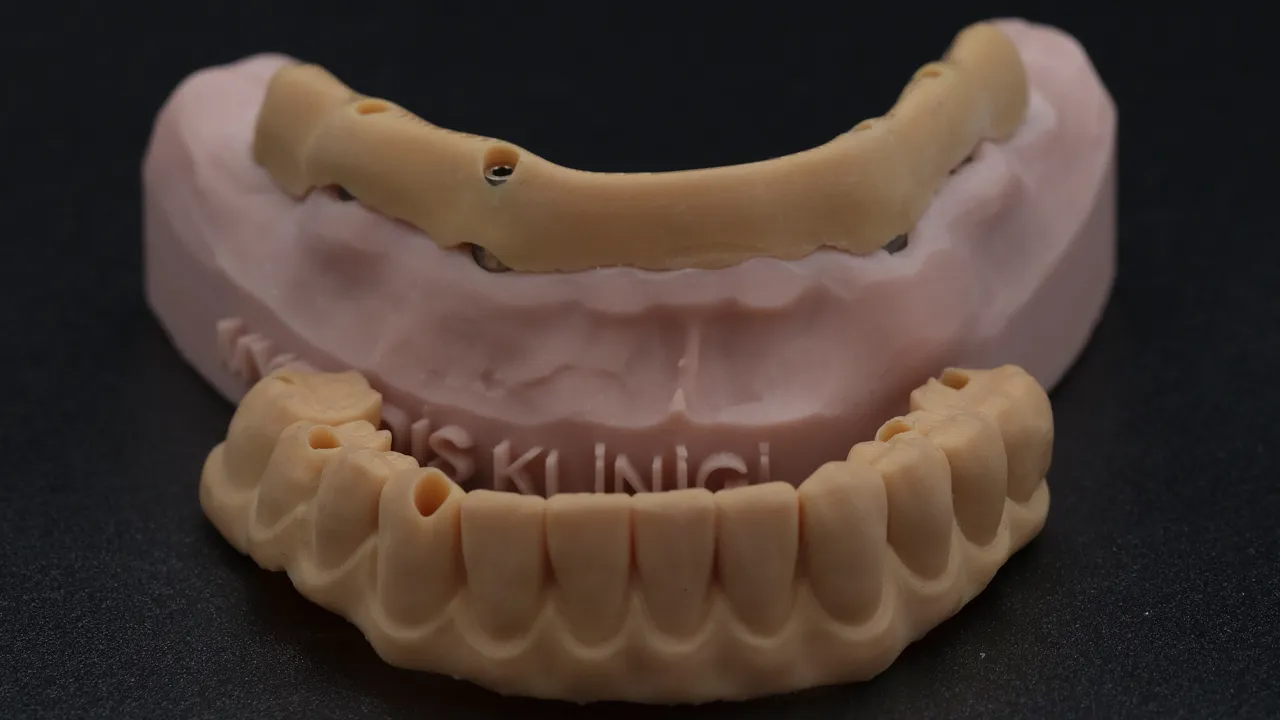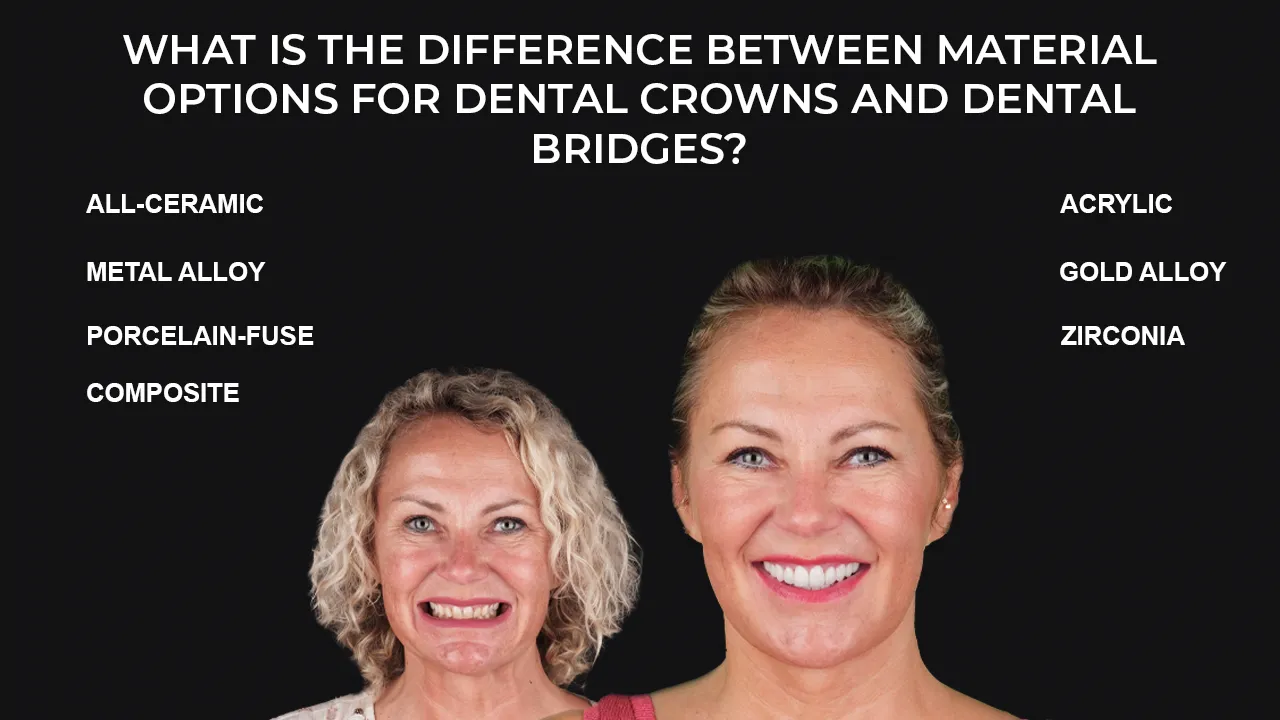Crowns vs Bridges are dental prostheses intended to rebuild and boost the performance and appearance of teeth, but they serve different goals and provide distinct benefits. Crowns vs Bridges are reliable dentistry treatments providing long-lasting and aesthetically acceptable answers to a variety of tooth ailments. The entire visible area around the damaged or weak tooth above the gum line is protected by dental crowns, sometimes called caps, which are separate prosthetic restorations. They are firmly bonded in place and are created to closely resemble the natural tooth in terms of size, shape, and colour.
Crowns are usually needed to restore teeth that have had root canal therapy, significant fillings, fractures, or significant deterioration. They restore function and aesthetics by fortifying, shielding, and supporting the tooth structure that remains. Dental bridges, however, are dental prostheses that replace one or more missing teeth by affixing artificial teeth to nearby natural teeth or implants. Dental crowns that are positioned over neighbouring teeth to support the bridge are joined to politics in bridge construction. They restore chewing function, prevent adjacent teeth from shifting, and improve smile attractiveness by filling gaps.
A few advantages of both crowns and bridges are better appearance, functional restoration, better chewing abilities, and a reduced risk of developing new dental issues. They support face features such as the cheeks and lips and aid in keeping the teeth in their right alignment. The patient's distinctive dental demands and the state of their teeth affect whether to use a bridge or a crown. Bridges are made for replacing one or more missing teeth in a row, while crowns are best for repairing individual teeth that are damaged.
What are the Advantages of Dental Crowns Compared to Dental Bridges?
The advantages of dental crowns compared to dental bridges make dental crowns a good remedy for certain dental conditions because they provide several advantages. Dental crowns have the important feature of being adaptable, as they are easily utilised to treat a variety of dental problems with specific teeth. Crowns are bespoke prosthetic restorations that completely enclose the visible part of a compromised or injured tooth above the gum line, giving the remaining tooth structure stability, strength, and protection. Crowns tend to be affixed to a single tooth without impacting surrounding teeth, in contrast to bridges, which necessitate the involvement of adjacent teeth as abutments. It implies that dental crowns protect the natural structure and integrity of neighbouring teeth, lowering the chance of issues, including decay or injury.
Dental crowns involve less tooth preparation than bridges, requiring just minor changes to the tooth structure to accept the crown. The long-term health and viability of the tooth are maintained in part by the preservation of the tooth structure. Dental crowns provide the best aesthetics because they are crafted to precisely match the size, shape, and colour of the original tooth, creating a seamless restoration that looks the same as the original tooth. Dental crowns are the best choice for recovering individual teeth that are weaker or broken than other alternatives due to their adaptability, conservative nature, and superior aesthetics when surrounding teeth are undamaged and in good health.

What are the Advantages of Dental Bridges Compared to Dental Crowns?
The advantages of dental bridges compared to dental crowns differ depending on the circumstances. The capacity of bridges to replace multiple lost teeth by securing prosthetic teeth (pontics) to nearby natural teeth or dental implants is a major feature. Bridges fill in the spaces left by missing teeth in the smile, as opposed to dental crowns, which are intended to repair specific teeth that are broken or weak. Bridges prevent neighbouring teeth from shifting, restore chewing function, and enhance overall appearance by using “pontics” connected to dental crowns to fix lost teeth.
Dental bridges serve to evenly distribute chewing forces and lower the risk of dental issues, such as gum disease and tooth decay by providing stability and support to the neighbouring teeth. Dental bridges have the potential to be a more affordable alternative to dental implants for replacing lost teeth, especially in cases in which several teeth are missing in a row. Dental bridges are a practical choice for patients looking for tooth replacement in a fast manner because they are a non-surgical procedure that is done in fewer dental appointments than dental implant insertion. Dental bridges are a better option than dental crowns when there is tooth loss or multiple adjacent teeth that require a restorative approach to remove missing teeth, regain functionality, and improve the look.
What are Dental Crowns?
Dental crowns are called dental prosthetics that completely cover the visible area of a weak or broken tooth above the gum line. The crowns give the remaining tooth structure strength, protection, and support. They are created to precisely match the size, shape, and colour of the original tooth and have a variety of materials, including porcelain, ceramic, metal alloys, or a combination of materials, customised to meet each patient's needs. Dental crowns' adaptability in treating a variety of dental conditions is one of its main characteristics. Crowns are often utilised to repair teeth that have had root canal therapy, significant fillings, fractures, or significant deterioration.
Dental crowns strengthen weak teeth, stabilise dental bridges or implants, and improve the appearance of discoloured or deformed teeth. Dental crowns are often preferred by individuals who have seriously damaged or weak teeth, need cosmetic enhancement for their teeth, or want to restore both functionality and appearance simultaneously. The ability of dental crowns to offer a long-lasting and visually beautiful solution for different types of dental issues is what gives them their special advantages. Crowns successfully restore the integrity and function of impaired teeth while maintaining their natural appearance due to their exceptional strength and longevity.
Dental crowns are carefully customised to blend in with the neighbouring teeth, guaranteeing a harmonious and natural-looking grin. Dental crowns are an alternative to conventional treatment that has long-term effects with little modification of the tooth's appearance. Dental crowns are a vital tool in rehabilitative dentistry because they offer a flexible and dependable solution for treating a variety of tooth disorders.
What are Dental Bridges?
Dental bridges are dental prostheses that are designed to replace missing teeth by securing dental implants or neighbouring natural teeth to pontics or artificial teeth. Pontics are used to cover the gap caused by missing teeth, and dental crowns are used to support the bridge by placing them over the surrounding natural teeth. Dental bridges give stability, functionality, and cosmetic appeal to the smile by being created to exact specifications in terms of size, shape, and colour to match the original teeth.
The capacity of dental bridges to restore chewing function and stop neighbouring teeth from shifting because of tooth loss is one of their primary advantages. They assist in keeping the teeth in their right alignment, guard against dental issues including gum disease and tooth decay, and enhance general oral health. People who have lost one or more teeth in a row, ones looking for a non-surgical tooth replacement option, or individuals looking for a more affordable alternative to dental implants favour dental bridges.
Dental bridges offer several special benefits, including the replacement of lost teeth, restoration of function, and enhancement of appearance. Bridges provide stability and support for neighbouring teeth, dispersing chewing forces evenly and lowering the risk of dental issues. Patients seeking immediate tooth replacement choose dental bridges because they are a more convenient treatment option and are done in fewer dental appointments than dental implant insertion. Dental bridges are a dependable and visually acceptable solution for replacing missing teeth while enhancing oral health and quality of life.
How to Care for Dental Crowns?
To care for dental crowns, several procedures need to be considered. Maintaining dental crowns' durability and efficacy requires proper maintenance. Dental crowns strengthen and improve the appearance of weak or broken teeth by acting as protective covers. Consistent maintenance guarantees that the crowns keep giving the underlying teeth the best assistance and protection. Effective dental crown maintenance requires following certain guidelines. Maintaining proper oral hygiene helps ward off plaque accumulation and tooth decay. It includes brushing twice a day with fluoride toothpaste and flossing in between teeth and around the crown.
Frequent dental check-ups and professional cleanings must be performed to monitor the health of the crowns and resolve any concerns quickly. Crown longevity is increased by avoiding utilising teeth as tools or chewing on hard items. People who have habits, such as clenching or grinding their teeth find it helpful to use a mouthguard to shield the crowns from excessive wear. Dental crown problems arise from improper maintenance in several ways. Plaque and bacteria tend to build up around the edges of crowns in the absence of proper dental hygiene, which raises the risk of gum disease and damage.
The crown eventually breaks due to compromising its quality over time. Failure to address concerns related to teeth grinding or clenching results in premature wear or damage to crowns. Skipping out on routine dental crown maintenance reduces its efficacy and needs expensive fixes or replacements. Regular maintenance is necessary to ensure the longevity and durability of dental crowns, which includes adhering to recommended care procedures.

How to Care for Dental Bridges?
To care for dental bridges, a few steps are needed to follow. Dental bridge maintenance is necessary to preserve general oral health and the longevity and functionality of the restorations. Dental bridges are prosthesis replacements that give the smile stability, functionality, and cosmetic appeal. Adequate maintenance guarantees that the bridges continue to function as planned and help avert problems. Dental bridge maintenance requires numerous crucial actions. The first step in preventing decay and gum disease is to practise proper oral hygiene, which includes brushing twice a day with fluoride toothpaste and flossing in between teeth and around the bridge to remove plaque and food particles.
Mouthwash with antibacterial components helps lessen microorganisms and preserve dental health. Regular dental check-ups and professional cleanings are required to monitor the condition of the bridges and resolve any concerns that arise. Bridges are kept in better condition and have a longer lifespan by not biting on hard or sticky foods. Wearing a mouthguard is beneficial for people who have habits, including clenching or grinding their teeth to prevent excessive wear on the bridges. Some people ask, “What is dental bridge?” It is one of the therapeutic dentistry techniques used to fill the gap created by losing teeth between neighbouring natural teeth or dental implants. Dental bridge problems arise from improper maintenance in some ways.
Plaque and germs build up around the edges of a bridge without proper dental hygiene, which raises the risk of gum disease and damage. The integrity of the bridge ends up compromised by it, leading to its collapse. Neglecting to treat problems, such as clenching or grinding teeth causes the bridges to wear down or break sooner than necessary. Failing to provide adequate care for dental bridges reduces their effectiveness and necessitates costly repairs or replacements. Regular maintenance and adherence to certain maintenance procedures are critical for ensuring the long-lasting quality of dental bridges.
How to Compare the Durability of Dental Crowns and Dental Bridges?
To compare the durability of dental crowns and dental bridges, there are factors to consider. The durability of dental crowns and dental bridges is critical because it affects their lifetime and effectiveness in restoring oral health and functionality. Dental bridges and crowns are prosthetic devices needed to treat an array of dental problems, including broken or missing teeth. Biting and chewing pressure must be withstood by such prostheses. Dental crowns and bridges are strong restorations that endure for many years. Some issues affect how long a restoration lasts more than others.
The material used in the creation of dental crowns and bridges has a major effect on how long they last. Materials that offer varying degrees of strength and resilience, such as porcelain, ceramic, metal alloys, or a combination of materials, are frequently used. The longevity of bridges and crowns is impacted by the accuracy of the fit and the calibre of the fabrication. The durability of dental restorations is impacted by additional variables, including dietary habits, oral hygiene practices, and habits, such as clenching or grinding teeth.
Bridges are slightly more prone to wear and tear because of the increased stress exerted on the supporting teeth, even though dental crowns and bridges are made to be durable. The abutment teeth eventually become loose due to it or cause gum disease, rotting, and other problems. Dental bridges and crowns offer durable options for regaining oral health and function with the right upkeep. Durability must be one aspect when weighing the pros and cons of dental crowns over bridges, other important factors to consider include general oral health, function, and aesthetics.
What is the Cost Difference Between Dental Crowns and Dental Bridges in Turkey?
The cost difference between dental crowns and dental bridges varies depending on several factors, such as selected materials, the intricacy of the treatment, and the dentist's location in Turkey. A dental crown costs between £140 to £300 per tooth, but a dental bridge costs around £627 for a three-unit Zirconia. Price differences reflect the complexity of the treatment and the materials and procedures involved. Dental bridges are often more expensive than dental crowns because they are more sophisticated and require more components.
Dental bridges increase the total expense of materials and lab work as they involve the manufacture of artificial teeth. An additional step required for the placement of a dental bridge is bonding the bridge and preparing the teeth that support it, which increases cost. Dental crowns are stand-alone restorations that are often less than dental bridges because they require less material and a simpler process. Individual costs vary depending on factors that involve the materials used, such as porcelain, ceramic, and metal alloys, the location of the dental clinic, and any extra operations required. Dental bridges tend to be more expensive when compared to dental crowns due to their extra components and more extensive procedures.

What is the Difference Between Dental Crowns and Dental Bridges In Terms of Aesthetic Appearance?
The difference between dental crowns and dental bridges in terms of aesthetic appearance
varies, mainly because of their different designs and purposes. Dental crowns are single prosthetic restorations that cover the visible part of a tooth above the gum line that is broken or weak. They have a seamless and realistic appearance because they are created to match the colour, size, and form of the natural tooth. Dental crowns that are made and positioned correctly match the surrounding teeth in colour and texture, simulating real enamel.
Dental crowns are affixed to neighbouring natural teeth or dental implants, while dental bridges are made up of several parts, including prosthetic teeth. The connecting crowns in dental bridges give the impression of being somewhat larger in comparison to individual crowns, even if the “pontics” are meant to resemble real teeth. More thorough tooth preparation is required for the implantation of dental bridges, which significantly impact the smile's appearance.
Which Is More Preferred Between Dental Crowns and Dental Bridges?
Dental bridges are the preferred method of treating back teeth than dental bridges because they allow dentists to create a bridge that covers the full arch. Most dental practitioners prefer to use bridges when treating rear teeth. Larger loss areas between adjacent natural teeth are served by such a type of bridge. Dental crowns are best used to correct minor front tooth loss. There is no chance of colour or shape variance when front tooth loss is treated with dental crowns because they blend in seamlessly with the neighbouring natural teeth. They give the neighbouring teeth the best protection and are more stable than a bridge.
The adaptability and conservative characteristics of dental crowns make them the favoured substitute over dental bridges on average. Dental crowns are single prosthetic restorations that cover the visible part of a tooth above the gum line that is broken or weak. They offer strength, support, and protection while maintaining the structure of the neighbouring teeth as they are built to precisely match the size, shape, and colour of the original tooth. The capacity of dental crowns to cure a variety of dental problems, such as significant decay, big fillings, fractures, or teeth that require root canal therapy, is one of their main advantages.
Dental crowns are a conventional treatment option that is placed on a single tooth without harming neighbouring teeth and require little modification to the tooth's form. Dental crowns have great aesthetics, fitting in well with neighbouring teeth to provide a grin that seems natural. Dental bridges require the implantation of several parts, such as dental crowns and prosthetic teeth, which are affixed to nearby natural teeth or dental implants. Dental bridges are more invasive and need the preparation of many teeth, however, they successfully replace lost teeth and restore function. Dental crowns are a preferred solution for many people undergoing restorative dental care because of their adaptability, consistency, and superb looks.
How Does the Application Process of Dental Crowns and Dental Bridges Differ?
The application process for dental crowns and dental bridges differs in several important ways, including complexity, time, and aftercare measures. Dental crowns are placed on individual teeth that need to be made more aesthetically pleasing or that have been damaged or weakened. The tooth is first prepared by the dentist, who removes any decayed or damaged tissue and reshapes it to fit the crown. A customised crown that resembles the natural tooth's size, shape, and colour is created by taking impressions of the prepped tooth. Dental glue is used to bond the crown onto the prepared tooth after it is manufactured in a dental laboratory.
Dental bridges are prosthetics used to replace one or more lost teeth by attaching dental implants or neighbouring natural teeth to artificial teeth. Dental bridge application requires preparing the teeth by removing a piece of their enamel to accommodate the crowns that support the bridge. Impressions of the prepped teeth are then obtained to make a custom bridge with the pontic and crowns for the abutment teeth. The bridge fills in the space left by the lost teeth by being created and then glued onto the teeth.
Dental bridge applications are more complex than dental crown applications because they include the preparation of several teeth and the manufacturing of extra components. The length of the operations differs in placing a dental bridge. It requires more time because it involves preparing several teeth and additional steps during the bridge-fitting process. Dental crowns and bridges require comparable aftercare practices, which include maintaining good oral hygiene by brushing and flossing teeth twice a day, using fluoride toothpaste, scheduling routine cleanings and checkups with a dentist, and so on.
Dental crowns and bridges are useful restorative alternatives for treating different dental disorders, however, the application process varies concerning complexity, time, and post-operative care. The location and degree of tooth loss or damage, fundamental oral health, and cosmetic objectives each play a role in determining the best course of treatment when deciding between dental crowns and bridges.
How to Compare Long-term Success Rates of Dental Crowns and Dental Bridges?
To compare the long-term success rates of dental crowns and dental bridges, comprehending various involved factors is necessary such as the success criteria, and the longevity-influencing aspects. Figuring out which alternative provides better results over time is the ultimate consideration.
Many factors affect the success rate of dental crowns and bridges, particularly their survival rate. Survival rate is the percentage of restorations that survive for a predetermined amount of time, typically many years, without needing to be replaced or significantly repaired. Evaluating the state of the supporting teeth's integrity and the surrounding gum tissue is another crucial measurement. Sustaining proper oral hygiene habits and guarding against gum disease and decay around the restoration is essential for lasting success.
Functional success is important because it assesses how successfully the restoration returns the mouth to its natural state. It encompasses restored communication, comfort throughout time, and the capacity to bite and chew. Cosmetic results are an additional indicator of the long-term viability of dental crowns and bridges. Patient satisfaction with the restoration's look is important, particularly for anterior teeth.
Dental crowns and bridges’ long-term success is influenced by several factors, including biomechanical forces, dental hygiene, preparation and suitability, and the choice of materials. Dental crowns and bridges are constructed from various materials, including metal alloys, all-ceramic, and porcelain-fused-to-metal (PFM). Each substance has pros and cons regarding durability, attractiveness, and compatibility with oral tissues. The long-term success of dental crowns and bridges is influenced by the fit of the restoration and the precision of tooth preparation. A good fit prolongs life and lowers the risk of bacterial infiltration.
Proper oral hygiene maintenance, which includes frequent brushing, flossing, and professional cleanings, is essential for any dental treatment to last longer. Another factor contributing to its long-term success is the biomechanical forces of the crowns or bridges. The pressures used when chewing are influenced by where the restoration is located in the mouth. Excessive occlusal forces cause teeth to become more stressed and to break.
Dental crowns and bridges each have benefits and drawbacks when it comes to lasting success. Dental crowns are known for their durability, ability to preserve tooth structure, and individual restoration. Long-term survival statistics for crowns are typically high, particularly when they are well-maintained. Dental crowns need less modification of the natural tooth structure compared to bridges, rendering them a more conventional choice. Dental crown restoration is easy. There is less chance of failure from stress on neighbouring teeth and more room for independent mobility since each tooth gets its crown.
Dental bridges are renowned for their durability, beautiful results, and useful restorations. Bridges give neighbouring teeth rigidity, especially when one or more teeth are missing and the space needs to be filled. Bridges additionally produce more aesthetically pleasing outcomes, particularly when several neighbouring teeth require restoration. Reliable Functional Restoration is provided via bridges. They efficiently restore the ability to chew, especially when several neighbouring teeth are gone.
What is the Difference Between Material Options for Dental Crowns and Dental Bridges?
The difference between material options for dental crowns and dental bridges is categorised based on quality and composition.
The material options for both dental crowns and dental bridges are listed below.
- All-ceramic: The all-ceramic crowns and bridges are completely composed of ceramic offering outstanding aesthetics since they closely resemble natural teeth. They are appropriate for individuals with metal allergies or sensitivities and offer good biocompatibility. All ceramic restorations are utilised in parts of the mouth that are visible and where aesthetics are crucial.
- Metal Alloy: Metal alloy crowns and bridges are renowned for their sturdiness, strength, and wear resistance such as cobalt-chromium or nickel-chromium. Metal alloys are not aesthetically pleasant compared to other options because of their metallic appearance, but they offer outstanding longevity. Metal alloy restorations are utilised for posterior teeth where strength and function are more important than appearance.
- Porcelain-Fused-to-Metal (PFM): PFM crowns and bridges are composed of a coating of porcelain that matches the colour of the tooth covering a metal substructure. They are used to restore both front and back teeth because of the combination of strength and beauty. They are more prone to chipping and, with time, the metal substructure becomes evident at the gum line, degrading aesthetics in contrast to the all-ceramic option.
- Composite Resin: Composite resin replacements are less employed for crowns and bridges because of durability issues. They have the advantage of being tooth-coloured making them appropriate for front tooth restorations where aesthetics are important. Composite resins are not as strong and enduring, especially for bridges that cross wider gaps, despite being cheaper than alternative options.
- Acrylic: Acrylic crowns and bridges are employed as interim restorations when undergoing extensive dental operations or waiting for a permanent restoration. Acrylic, however, is not durable or resilient despite being economical, lightweight, and easily customizable as permanent materials.
- Gold Alloy: Gold alloy crowns and bridges are widely recognized for their durability, biocompatibility, and least amount of wear on neighbouring teeth. Gold alloys are primarily used on posterior teeth as their metallic look makes them unsightly in sections of the mouth that are visible. They provide exceptional longevity and flawless fit.
- Zirconia: Zirconia crowns and bridges are renowned for their remarkable resilience, natural-looking look, and extraordinary strength. They are appropriate for both anterior and posterior restorations because of their exceptional appearance, biocompatibility, and durability against chipping and cracking.

The preference between dental crowns and bridges, based on material variety, is anticipated to lean towards crowns. It is because of the dental crown's ability to accommodate a greater variety of cosmetic functional and financial preferences such as PFM, all-ceramic, zirconia, and gold alloy. Crowns are additionally made specifically for each tooth, giving treatment planners more freedom and enabling the best-desired results.
Zirconia is the material of choice for dental crowns and bridges since it combines exceptional strength, durability, natural appearance, and biocompatibility. Zirconia crowns and bridges have outstanding resistance to deterioration, cracking, and fractures, giving clients lasting, aesthetically beautiful outcomes. The decision, however, is made according to the unique requirements and conditions of every patient. The dentist's opinion according to elements such as tooth placement, circumstance, and aesthetic considerations is another influencing factor.
How Do the Side Effects of Dental Crowns and Dental Bridges Differ?
The side effects of dental crowns and dental bridges differ in terms of their influence on nearby teeth and the oral tissues in the area. Tooth discomfort or gum irritation results from dental crowns, especially if the crown fits incorrectly or if the tooth's nerve is damaged during preparation. Dental bridges increase the risk of gum recession and tooth decay in the teeth that support the bridge because of the additional strain and challenge of maintaining good oral hygiene surrounding the bridge. Patient's unique oral health needs and preferences must be taken into account, together with the dentist's advice to reduce the risk of adverse effects and guarantee long-term success when deciding between dental crowns and bridges.
The side effects of dental crowns include tooth sensitivity, gum irritation, tooth decay, and allergic Reactions. Some patients report feeling more sensitive to heat or cold following the placement of a dental crown, particularly if the tooth's nerve was compromised during the preparation procedure. Roughly edged or ill-fitting crowns cause discomfort or inflammation to the gums. Deterioration occurs under the crown if the borders of the crown are not sufficiently sealed onto the tooth, allowing germs to grow. People experience allergic reactions to dental cement or metal alloys used in crowns in rare cases.
A higher risk of tooth decay, gum recession, difficulty in maintaining dental sanitation, and potential for bridge failure are among the negative effects associated with dental bridges. The supporting teeth are progressively more vulnerable to deterioration since dental bridges entail bonding replacement teeth to neighbouring natural teeth. Gum recession is caused by the bridge's strain on the supporting teeth over time, which exposes the teeth's roots and causes pain. Cleaning the area around and beneath the bridge gets difficult, which results in gum disease, plaque buildup, and potential tooth decay in the supporting teeth. Structural problems with bridges include artificial tooth fractures, crumbling of the cement anchoring the bridge in place, and damage to the teeth that reinforce the bridge.
Dental bridges are associated with a somewhat increased risk of adverse consequences when compared to dental crowns because neighbouring teeth are involved in supporting the treatment. Bridges carry a higher risk of gum recession, tooth decay, and difficulties maintaining good oral hygiene. Dental crowns are recommended over bridges in situations where maintaining the integrity of the tooth structure and reducing the occurrence of complications are priorities. The final decision between the two, however, is based on the unique requirements and conditions of the client and the dentist's opinion.
How Do Dental Crowns and Dental Bridges Differ in Treatment Time?
Dental crowns and dental bridges differ in treatment time based on how many appointments are required to complete the process, which includes making impressions of the teeth, placing the final crown, and preparing the teeth.
Treatment time describes the amount of time needed to finish a dental restoration from the point of start preparation to the point of final installation. The complexity of the case, the number of teeth involved, the kind of restoration, the necessity of further treatments like root canal therapy or tooth extraction, and the patient's general oral health are some of the factors that affect how long treatment takes.
Treatment for dental crowns takes place throughout two appointments. The tooth is prepped for the crown during the initial session by having any cavities or damage removed and by being reshaped. A dental laboratory fabricates an impression-based custom-fitted crown after that. A temporary crown is affixed to safeguard the prepared tooth in the interim.
Dental bridges typically require more time to treat than crowns due to their more extensive nature. The bridge must be made at a dental laboratory, the supporting teeth (abutments) must be prepared, imprints must be taken, and the bridge must be constructed before being finally placed. The period of the treatment increases if any supporting teeth need additional procedures such as root canal therapy or extraction.
Dental crowns are often preferred over bridges solely because of treatment time. Dental crowns typically offer a simpler and faster treatment procedure compared to bridges. Crowns are more suitable for individuals with hectic schedules or patients wanting a speedier restoration since they involve fewer consultations and a simpler procedure. Additional considerations, however, must be taken into account when deciding between crowns and bridges, such as the degree of tooth damage, the stability of neighbouring teeth, and the desired cosmetic result. Clients must speak with their dentist to choose the best course of action for their unique needs and circumstances.
What is the Importance of Choosing the Right Dentist for Getting Dental Crowns and Dental Bridges?
The importance of choosing the right dentist for getting dental crowns and dental bridges lies in its capacity to ensure the best dental treatment results and general oral health of the patients. The quality and durability of the restorations are greatly impacted by the role that a trained and experienced dentist performs in each stage of the procedure, from the first examination to the last placement.
The dentist's job is to precisely diagnose the client's dental status and choose the best course of action. A qualified dentist carefully considers several criteria when recommending a restoration option, such as a crown or bridge. The criteria include the extent of tooth damage, the state of neighbouring teeth and gums, and the patient's total dental condition.
The skill of the dentist in preparing teeth, taking impressions, and fabricating restorations has a direct bearing on how well the crowns or bridges fit. Correct imprints are essential for producing custom-fitted restorations that fit in smoothly with the natural dentition. Precise tooth preparation guarantees the best retention and durability of the restoration. Good alignment, bite obstruction, and cosmetic harmony depend on the dentist's skill in completing the final crown and bridge installation. A proficient dentist guarantees that the restorations are firmly bonded or cemented into position, reducing the risk of issues like dislodgement or early failure.
Selecting the incorrect dentist for bridges and crowns has several dangerous repercussions. Dental diseases are misdiagnosed by inexperienced or undertrained dentists, which results in ineffective treatment plans or less-than-ideal results. Inadequate execution of tooth preparation, impression taking, or restoration placement leads to crowns and bridges that are ill-fitting or not functioning well, which raises the risk of issues like decay, gum irritation, or fracture. Clients are left vulnerable to permanent dental issues by untrained dentists who lack the expertise or abilities to handle potential problems or offer appropriate follow-up treatment.

A competent and knowledgeable dentist reduces the occurrence of difficulties, gives individualised care, and skillfully carries out treatment methods, which result in restorations that are durable, useful, and aesthetically appealing. Choosing the correct professional, regardless of the Dentist Types, is crucial to getting the best attainable results, satisfying clients, and preserving permanent oral health for dental crowns and bridges.





